|
|
 |
Fiche d'espèce de Copépode |
|
|
Calanoida ( Ordre ) |
|
|
|
Calanoidea ( Superfamille ) |
|
|
|
Calanidae ( Famille ) |
|
|
|
Calanoides ( Genre ) |
|
|
| |
Calanoides philippinensis Kitou & Tanaka, 1969 (F,M) | |
| | | | | | | Syn.: | Calanoides carinatus : Vervoort, 1946 (p.29, figs 1-3) | | | | Ref.: | | | Kitou & Tanaka, 1969 (p.67, figs.F,M); Bradford & Jillett, 1974 (p.9, Rem.); Fleminger, 1985 (p.275, 285, Table 1, 4, figs.F, M, Rem.: A1); Bradford, 1988 (p.77, 78, Rem.); Chihara & Murano, 1997 (p.741, Pl.65: F,M); Mulyadi, 2004 (p.11, figs.F,M, Rem.); Sabatini & al., 2007 (p.360, tab.4, 5); Bradford-Grieve & al., 2017 (p.807, 831, Figs 1, 2, Table 1, 5) | 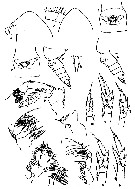 issued from : M. Kitou & O. Tanaka in Oceanogr. Mag., 1969, 21 (1). [p.69, Fg.1]. Female: a-b, forehead (lateral and dorsal, respectively); c, last thoracic segment and urosome (lateral); d, same from another specimen; e, genital segment (ventral)f, same (ventral); g, rostrum; h, A2; i, Md (gnathobase); j, Mx1; k, Mx2; l, Mxp, m, P1; n, P2; o, P3; p, P4; q, P5. Body length of specimens: 2.64 mm (a, c, e); 2.74 mm (b, d; 2.84 mm (f). Nota : Cephalothorx and urosome in the proportonal lengths 81 : 19. forehead triangular in shape, and with a slight chitinous thickening on the anterior (in dorsal view). Rostral filaments slender. Proportional lengths of the urosomal segments and caudal rami 42 : 15 : 13 : 11 : 19 = 100 ; Genital segment nearly as long as width and swollen laterally at the middle section. Genital area protrudes below. Genital opening resembles that of C. carinatus but can be distinguished from that of the latter by differences in structure to some extent. Caudal rami 1.4 times as long as width. A1 extends to the distal margin of the genital segment. A2, Md, Mx1, Mx2, Mxp as those of C. carinatus (Vervoort, 1947). Nota: In the P2 to P4, the exopodal segment 2 is furnished with a group of spinules on the posterior surface (these spinules are also found in the specimens of C. carinatus taken from the Antarctic region).
|
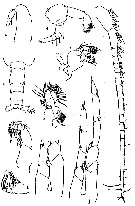 issued from : M. Kitou & O. Tanaka in Oceanogr. Mag., 1969, 21 (1). [p.70, Fg.2]. Male: a, forehead (lateral); b, last thoracic segment and urosome (dorsal); c, right A1; d, A2; e, Md; f, Mx1; g, Mx2; h, Mxp; i, P5 (incomplete); j, P5. Body length of specimens: 2.65 mm (a, b, j); 2.60 mm (i). Nota : Cephalothorax and urosome in the proportional lengths 77 : 23. Forehead evenly rounded (in lateral aspect). There is a small swelling on the dorsal surface just opposite of the place of the attachment of the A2. Proportional lengths of the urosomal segments and caudal rami 16 : 28 : 16 : 14 : 14 : 12 = 100. Caudal rami 1.5 times as long as width. A1 21-segmented, extends to the distal margin of the caudal rami ; proximal segments furnished with long sensory filaments. A2 slightly deformed ; exopod and endopod nearly equal lengths ; exopod 6-segmented and furnished with 4 marginal setae. Md degenerates much ; the cutting edge is provided with a single tooth. Mx1 degenerates ; 1st inner lobe without seta ; 2nd lobe with 1 small pointed lamellous process ; 3rd lobe with 4 short setae. Endopod with 3, 2, 3 setae on the segments 1 to 3. The 2nd basal with 4 setae. The outer lobe with 7 setae. The exopod with 10 setae.Mx2 degenerates in the armature of setae on the lobes. Mxp robust. P5 : exopod 3-segmented, degenerated endopod on each side.
|
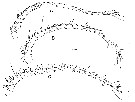 issued from : A. Fleminger in Mar. Biol., 1985, 88. [p.282, Fig.4]. Left A1 (ventral view); A (from 4°05.6'S, 133°34.5E): Male; B, quadrithek female; C, trithek female. Nota: see remarks in Calanus pacificus californicus (Fleminger, 1985) concerning the dimorphism in the female A1.
|
 issued from : M. Kitou & O. Tanaka in Oceanogr. Mag., 1969, 21 (1). [p.72]. Female: Proportional lengthsof the outer margin of the 3rd segment of the exopod divided by the marginal spine in the specimens measuring 2.64 and 2.74 mm. Nota: These datae do not coincide with those for C. carinatus given by Giesbrecht & Schmeil (1898).
|
 issued from : M. E. Sabatini, F. C. Ramirez & J. Bradford-Grieve in Invert. Syst., 2007, 21. [p.361, Table 4]. Comparison characters to distinguish Females C. philippinensis.
|
 issued from : M. E. Sabatini, F. C. Ramirez & J. Bradford-Grieve in Invert. Syst., 2007, 21. [p.361, Table 5]. Comparison characters to distinguish Males C. philippinensis.
|
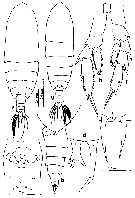 issued from : Mulyadi in Published by Res. Center Biol., Indonesia Inst. Sci. Bogor, 2004. [p.12, Fig.2]. Female (from Indonesian Seas): a, habitus (dorsal); b, urosome (lateral left side); c, genital complex (ventral); d, abnormal rostrum (anterior view); e, rostrum (anterior view); f, P5. Immature female: g, habitus (dorsal); h, P5.
|
 issued from : Mulyadi in Published by Res. Center Biol., Indonesia Inst. Sci. Bogor, 2004. [p.13, Fig.3]. Female: a-d, P1 to P4, respectively.
|
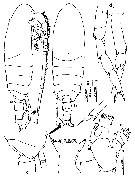 issued from : Mulyadi in Published by Res. Center Biol., Indonesia Inst. Sci. Bogor, 2004. [p.14, Fig.4]. Male; a-b, habitus (lateral and dorsal, respectively); c, angle of last thoracic segment and genital somite (lateral); d, P5 (R : right leg; L = left leg); e, Md (palp); f, Md (mandible blade).
|
 Issued from : V.N. Andronov in Russian Acad. Sci. P.P. Shirshov Inst. Oceanol. Atlantic Branch, Kaliningrad, 2014. [p.73, Fig.19, 5]. Calanoides philippinensis after Kitou & Tanaka, 1969. Male P5.
|
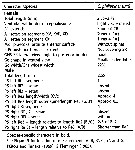 Issued from : J.M. Bradford-Grieve, L. Blanco-Bercial & I. Prusova in J. Nat. Hist., 2017, 51 (13-14) [p.828, Table 5]. Character states distinguished known of Calanoides. A1 = antennule, a = aesthetasc; approx. = approximately; CR = caudal rami; Gns = genital double-somite; Go = genital operculum; ms = modified seta; Pd5 = pedigerous somite 5; P5 = fifth leg; Re = exopod; Ri = endopod; SR = seminal receptacle; St = terminal spine.
|
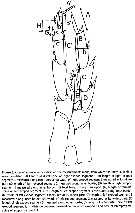 Issued from : J.M. Bradford-Grieve, L. Blanco-Bercial & I. Prusova in J. Nat. Hist., 2017, 51 (13-14) [p.812, Fig. 3]. Calanoides male P5 indicating the measurements made, from which the ratios in Table 4 and 5 were calculated.
| | | | | Ref. compl.: | | | Fleminger, 1986 (p.84, figs. 3, 4, Rem.); Baars & al., 1990 (p.538: Rem.); Othman & al., 1990 (p.568: Rem.); Arinardi, 1991 (p.292); Lo & al., 2001 (1139, tab.I); C.-Y. Lee & al., 2009 (p.151, Tab.2); Mulyadi & Rumengan, 2012 (p.202, Rem.: p.204); Tseng & al., 2013 (p.507, seasonal abundance) | | | | NZ: | 4 | | |
|
Carte de distribution de Calanoides philippinensis par zones géographiques
|
| | | | | |  Issued from : A. Fleminger inComposite stations of the Siboga Expedition (1899), the Snellius Expedition (1929) and R/V ''Alpha Helix'' Moro Expedition (1979). Issued from : A. Fleminger inComposite stations of the Siboga Expedition (1899), the Snellius Expedition (1929) and R/V ''Alpha Helix'' Moro Expedition (1979).
Stations are indicated by small filled circles, Calanoides philippinensis records by open diamonds, and Rhincalanus nasutus records by a large filled circles.Note how positive records are concentrated off southwestern New Guinea. |
| | | | Loc: | | | Indonesian Seas (Lombok Sea, Flores Sea, Ceram Sea, Arafura Sea, Banda Sea, N Celebes), off E Philippines, Pacif. (W tropical), China Seas (East China Sea), NW & NE Taiwan, SW Korea, SE Japan
Originally described from the Kuroshio Current region (20-30° N) between the northern Philippine Islands region to off southeastern Japan (Kitou & Tanaka, 1969), also recorded from the Banda and Arafura Seas (Arinardi & al., 1990; Baars & al., 1990) and from specimens from the Aru basin (I. Prusova). A species of Calanoides has been recorded off the northwest shelf of Australia (9-14° S) by Tranter (1977) during the southeast monsoon, which may prove to be C. philippinensis. Calanoides , are also recorded off the coast of Western Australia at about 30° S (Stephen, 1998). | | | | N: | 10 | | | | Lg.: | | | (324) F: 2,79-2,55; M: 2,65; (866) F: 2,6-2,8; M: 2,5-2,7; (1122) F: 2,6; M: 2,55; {F: 2,55-2,80; M: 2,50-2,70} | | | | Rem.: | épi-mésopélagique.
Peut-être confondu avec C. carinatus
Voir aussi les remarques en anglais | | | Dernière mise à jour : 09/10/2018 | |
|
|
 Toute utilisation de ce site pour une publication sera mentionnée avec la référence suivante : Toute utilisation de ce site pour une publication sera mentionnée avec la référence suivante :
Razouls C., Desreumaux N., Kouwenberg J. et de Bovée F., 2005-2025. - Biodiversité des Copépodes planctoniques marins (morphologie, répartition géographique et données biologiques). Sorbonne Université, CNRS. Disponible sur http://copepodes.obs-banyuls.fr [Accédé le 29 août 2025] © copyright 2005-2025 Sorbonne Université, CNRS
|
|
 |
 |













